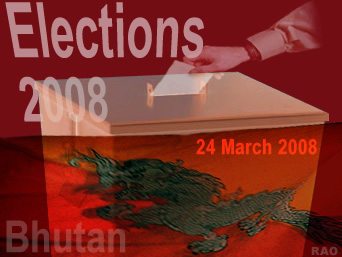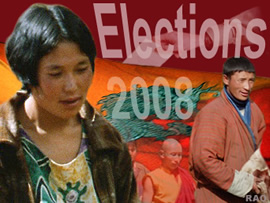 |
Bhutan Politics - Elections |
|
 |
Bhutan Politics |
 |
|
 |
|
National
Assembly election 2008
|
 |
 |
| The
Election Commission of Bhutan has announced that ...
 Bhutan's
first general elections that will elect 47 candidates to the National Assembly
will be held on 24 March 2008. Bhutan's
first general elections that will elect 47 candidates to the National Assembly
will be held on 24 March 2008.
The
National Assembly election period begins with the two political parties
submitting the letter of intent, stating the list of their candidates,
copy of their election manifestos, audited financial statues among others,
on January 22 to the commission. |
|
The
party manifestos will also be released on the same day and the election
campaign will formally begin.
Filing
in nomination of candidates will be done 31 January to 7 February
2008, after which candidates can start campaigning if their nomination
is accepted.
While
the timing for the TV debates between the party presidents has not been
announced, debates between candidates in the constituencies will start
from 7 February 008.
The
Druk Phuensum Tshogpa and the Peoples Democratic Party are the two parties
contesting Bhutan's first historic election.
 |
| Source:
Kuensel, Bhutan's National Newspaper, January 2008 |
top
|
Parliamentary
election months announced
|
 |
The
Royal Decree, which was read out by the Chief Election Commissioner at
a press conference in Thimphu, stated that with the conclusion of the 87th
session of the National Assembly the country will now embark on the formal
process towards a democratic constitutional monarchy.
In
the Royal Decree, His Majesty said that to encourage early formation of
political parties and declaration of interest by candidates, the timeline
for elections to the two houses of Parliament must be announced. The Royal
Decree also called on all Bhutanese who have the desire, qualifications
and skills to serve the country through the political process to come forward.
The
ECB has also launched a handbook for candidates contesting the elections
to Parliament and local government.
The
handbook explains in detail aspects of the Election Bill, which relate
directly to the candidates.
For
instance, a chapter on funding in the handbook specifies the expenditure
ceiling of candidates. In the National Council elections expenditure incurred
by a contesting candidate must not exceed Nu. 100,000 and in elections
to Dzongkhag Tshogdues and Thromde Tshogdes the expenditure of the candidate
must not exceed Nu. 50,000.
In
the General Election a candidate can, in addition to the funds received
from the ECB, incur expenditure from funds received from his or her party.
The amount however should not exceed the fund provided by the ECB which
is 100,000 each for the primary round of the National Assembly election
and for the general elections.
The
handbook also includes a chapter on reservation of symbols but it does
not specify the type of symbol a political party can have or use for the
Assembly elections.
Earlier,
ECB had announced that the symbols and colours (blue, green, red, yellow)
used in the mock election will not be allowed in the real elections but
it has not been mentioned in the handbook.
For
National Council and Local Government elections, candidates must provide
the name and photograph instead of a symbol.
Chapters
on election campaigning, nomination of candidates, qualification and disqualification
of candidates and electoral offences are all in the handbook.
The
ECB also introduced stickers with slogans of forming good political parties
and party politics.
 |
| Contributed
by Phuntsho Choden, Kuensel, Bhutan's National Newspaper,
July 2007 |
| Links |
 |
 |
 |
External
Links |
|




